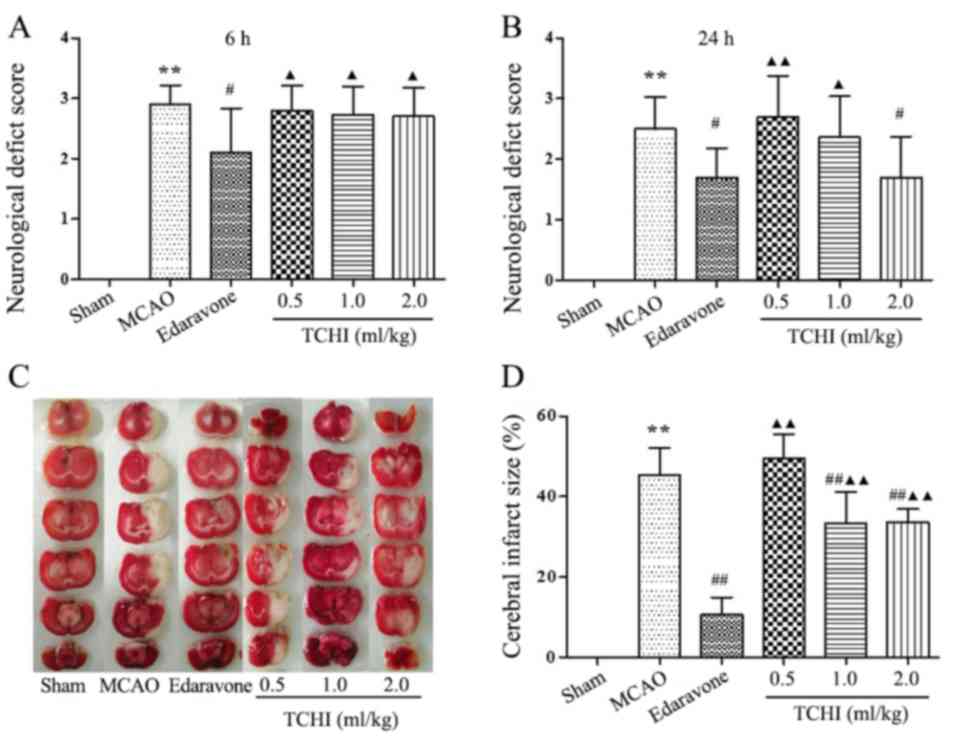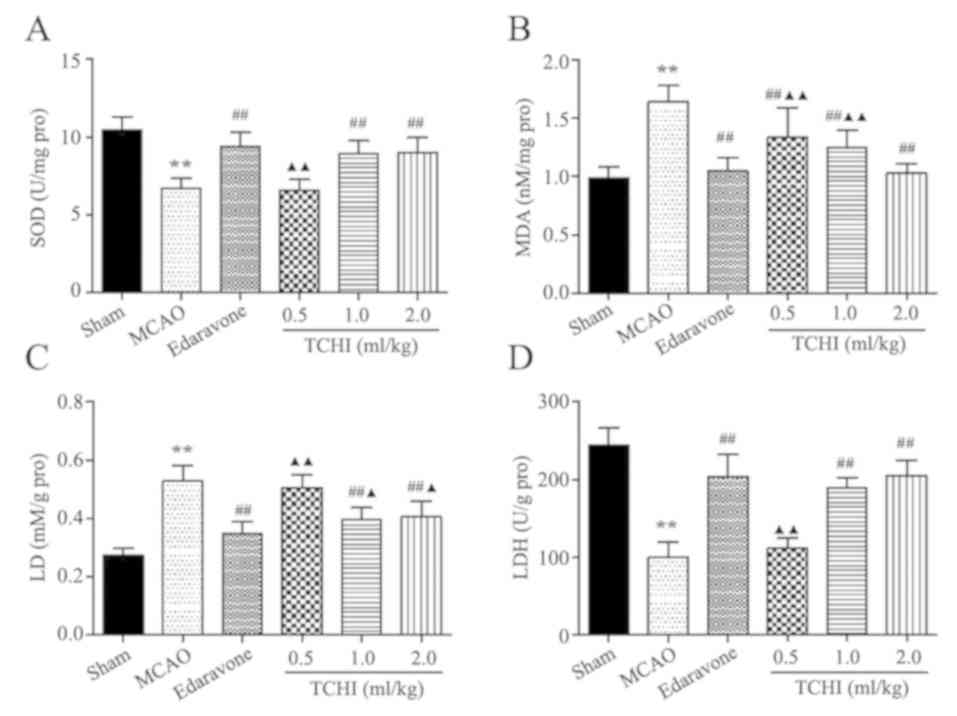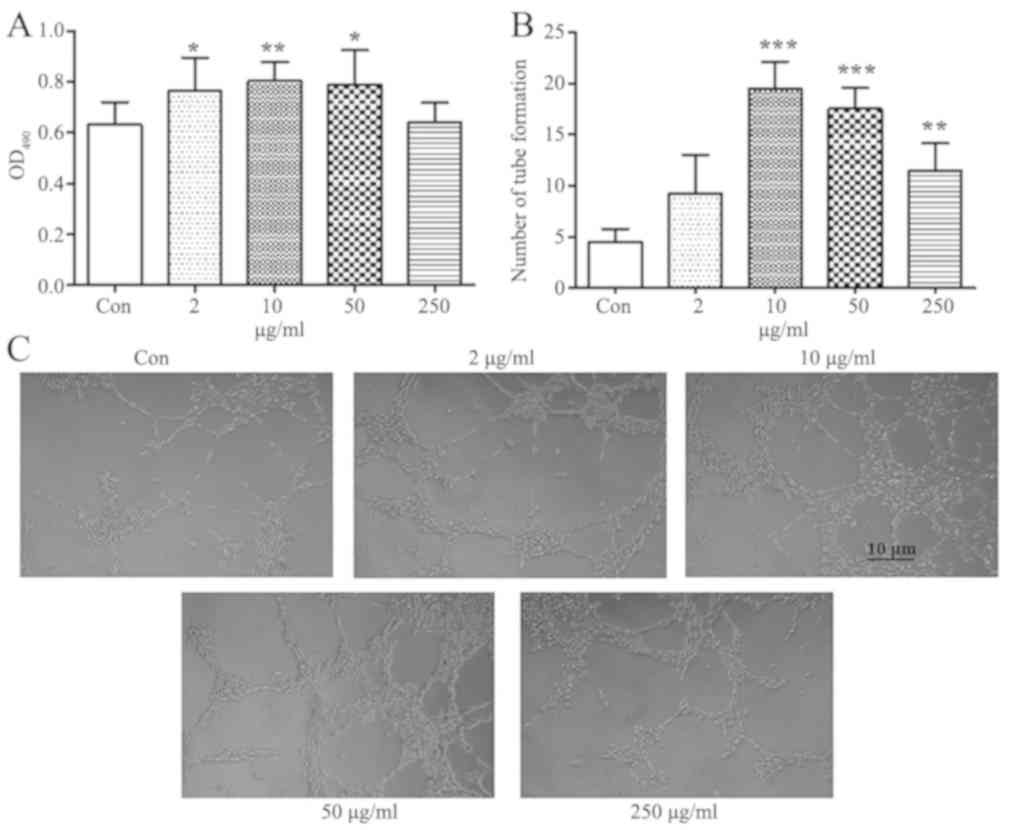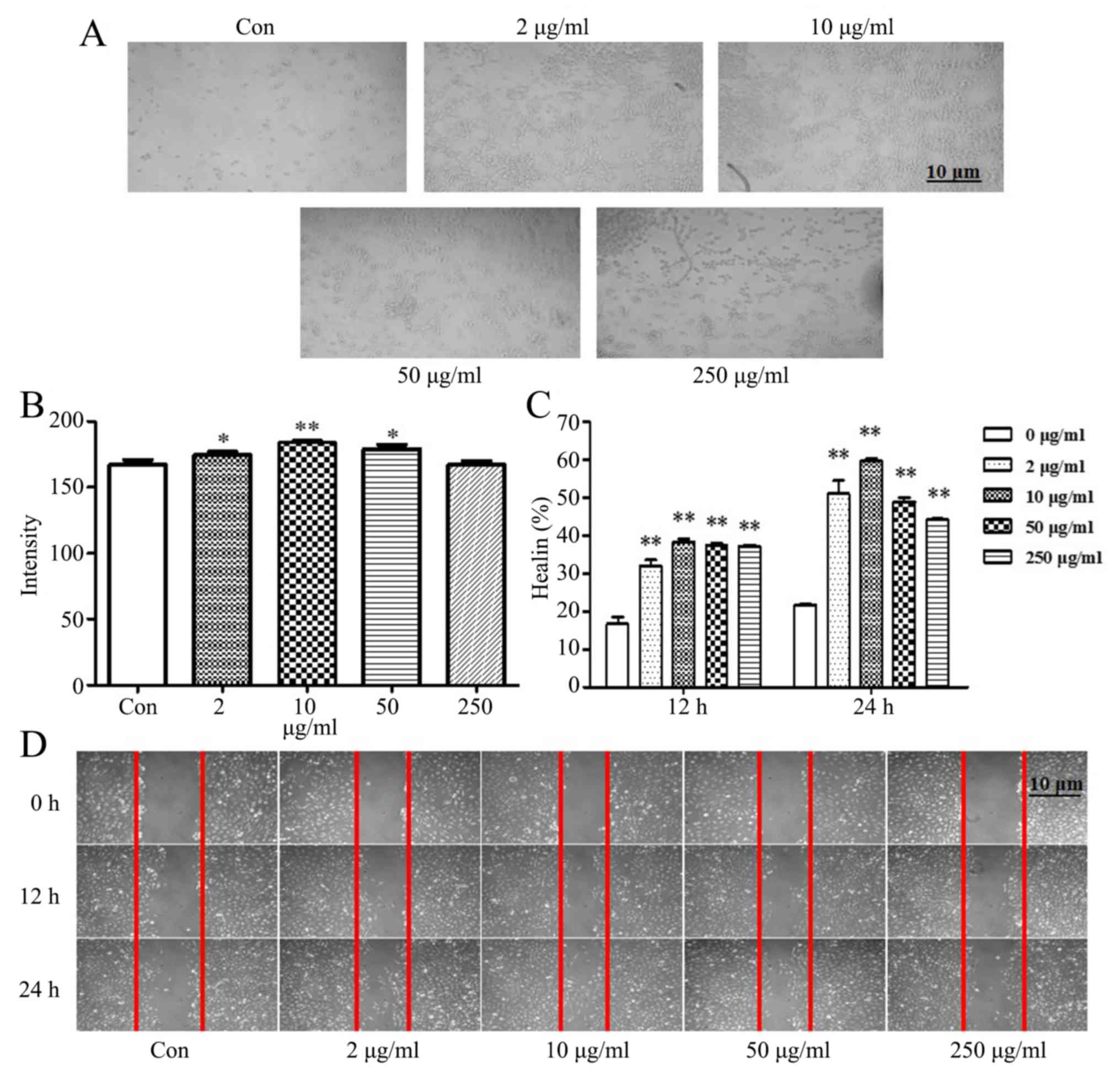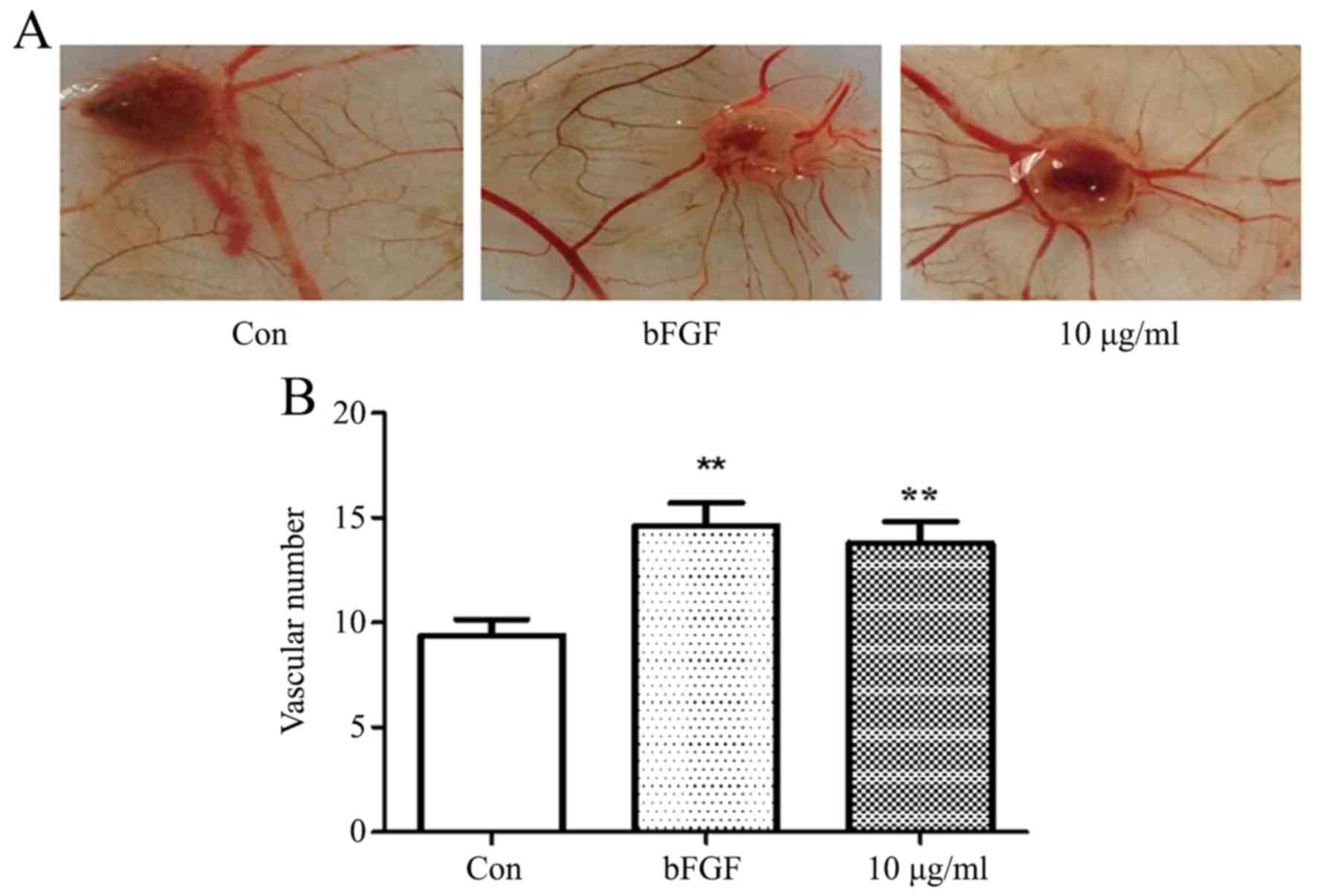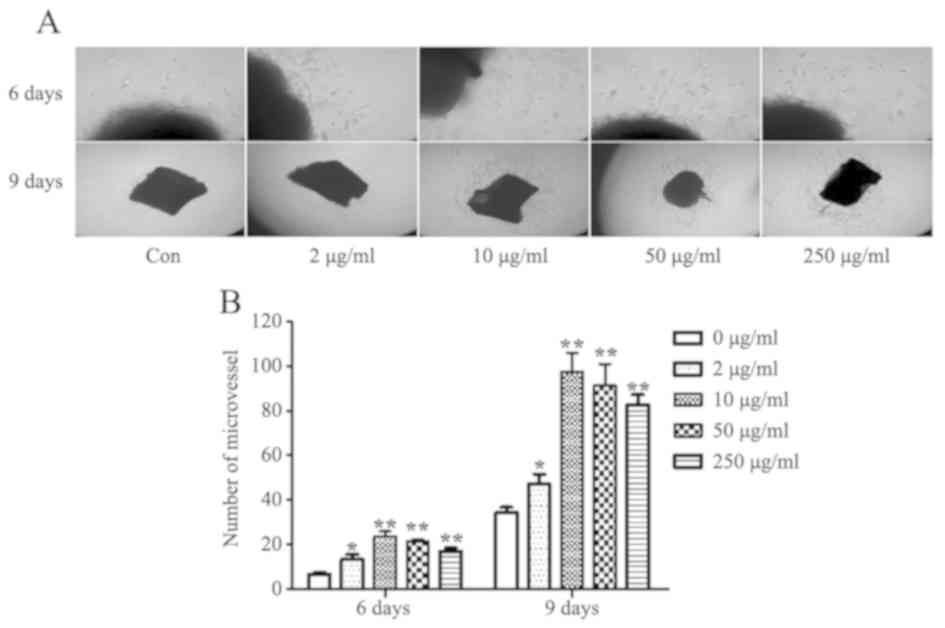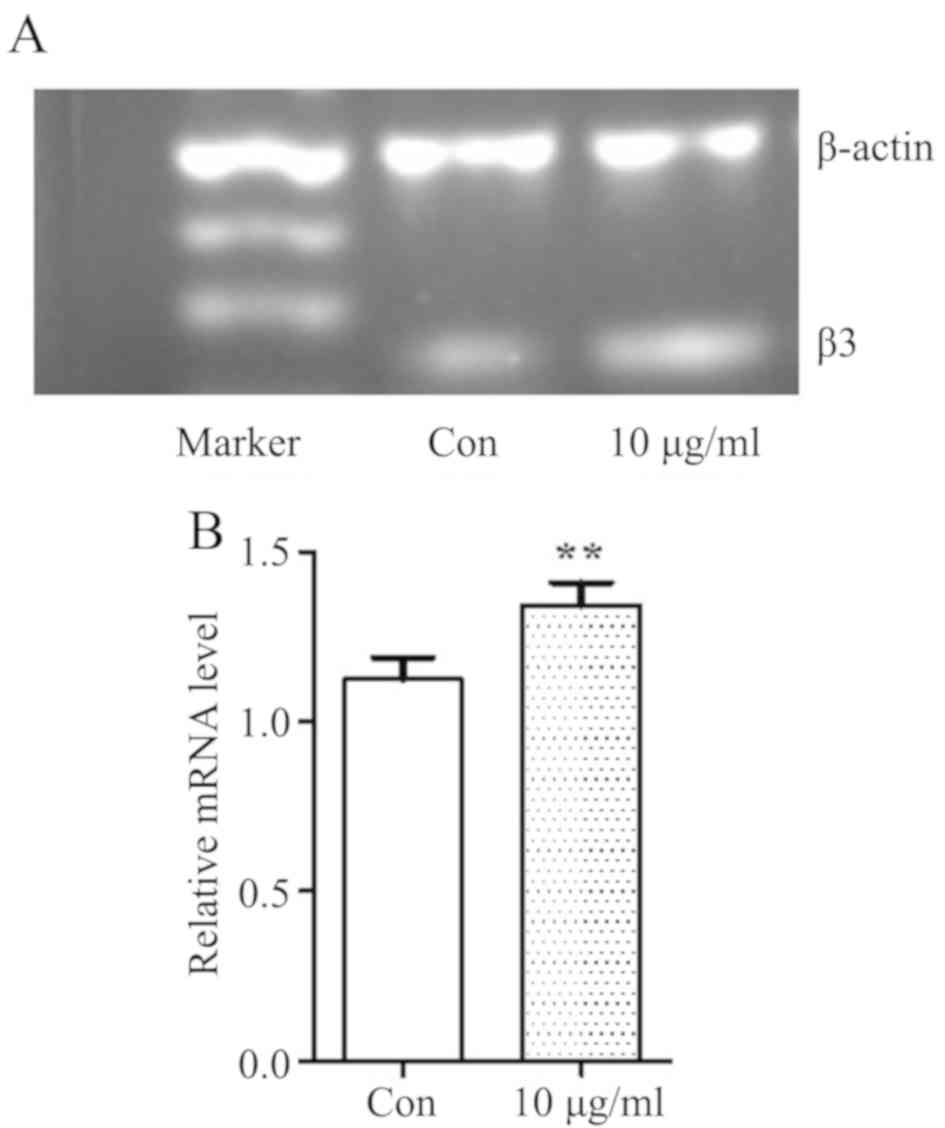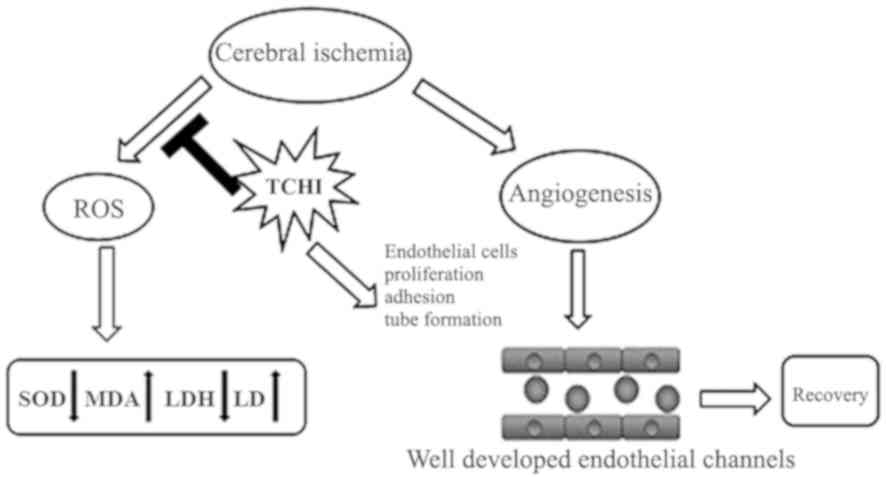Protective effect of troxerutin and cerebroprotein hydrolysate injection on cerebral ischemia through inhibition of oxidative stress and promotion of angiogenesis in rats
- Authors:
- Published online on: February 15, 2019 https://doi.org/10.3892/mmr.2019.9960
- Pages: 3148-3158
-
Copyright: © Ma et al. This is an open access article distributed under the terms of Creative Commons Attribution License.
Abstract
Introduction
Brain ischemia, also known as cerebral ischemia or ischemic stroke, is a condition involving insufficient blood flow to the brain to meet metabolic demand and is a leading cause of mortality worldwide, causing serious long-term disability (1,2). The treatment strategies of brain ischemia, particularly acute ischemic stroke, currently include thrombolytic, antiplatelet aggregation and neuroprotective therapy, among which thrombolytic therapy remains the sole effective treatment. However, there is a lack of effective therapies to improve functional recovery in the cerebral post-ischemic phase, while the treatment for ischemic stroke is restricted to a narrow therapeutic time window and holds the risk of hemorrhage (3). Thus, the mechanism of cerebral ischemia and the treatment of post-stroke patients remain under investigation (2).
Oxidative stress, characterized by excessive production of reactive oxygen species (ROS), is a recognized mechanism of cerebral ischemic injury (4,5). As a result, antioxidants are considered to be a conventional therapeutic strategy in the treatment of cerebral ischemic injury. Superoxide dismutase (SOD) is a first-in-line endogenous defense against ROS and specific scavengers of the superoxide anion, which eliminates oxygen-free radicals to prevent excessive superoxide anion concentration damage and serves an important role in maintaining the normal physiological activity of the body. Furthermore, as the product of lipid peroxidation induced by oxygen-free radicals, the malondialdehyde (MDA) content in tissues effectively reflects the degree of cell damage and free radical attacks in the body (6). A number of studies have confirmed that SOD, lactate dehydrogenase (LDH) and MDA levels in brain tissue were abnormal following cerebral ischemia (7,8). In addition, recent studies demonstrated that the promotion of angiogenesis and the formation of new blood vessels from pre-existing vessels may be a novel strategy to reduce the infarct volume and improve neurobehavioral recovery following ischemic stroke (2,9). Enhancement of endothelial cell functions, including adhesion, migration, proliferation and differentiation, is critical for inducing neovascularization to provide the required nutrients, oxygen and blood-flow for ischemic tissues during the process of angiogenesis.
Troxerutin, is a flavonol used as a vascular protective and antioxidative agent, and cerebroprotein hydrolysate includes brain protein hydrolysate, sialic acid. The troxerutin and cerebroprotein hydrolysate injection (TCHI) has been approved by the State Food and Drug Administration of China for the amelioration of cerebral ischemic conditions based on neuroprotective effects exerted in clinical practice (10). Troxerutin has the effect of lowering blood viscosity, inhibiting platelet aggregation, promoting the formation of collateral circulation, improving microcirculation and eliminating free radicals, and can further effectively inhibit the formation of thrombi and promote the repair of damaged nerve tissue (11). Bayer et al (12) demonstrated that sialic acid increases blood vessel formation. Other studies have suggested that sialic acid interacts with extracellular matrix (ECM) components and growth factors, regulating cell adhesion, migration and proliferation (13). Endothelial cells express several integrin heterodimers, including αvβ3, α5β1 and αvβ5. Among these, integrin β3 is a critical cell adhesion molecule in angiogenesis (14). The expression of integrin β3 on the endothelial cell surface activates and promotes endothelial cell proliferation, thereby promoting angiogenesis (15). A previous clinical study suggested that TCHI improves neurological recovery in patients with acute cerebral infarction (16). It was further demonstrated that TCHI supports a shortening of coma duration, and improves the quality life and long-term outcomes (17). Therefore, it is speculated that TCHI protects against cerebral ischemic injury via attenuation of oxidative stress or promotion of angiogenesis. However, the detailed mechanism underlying the effectiveness of TCHI in cerebrovascular diseases requires further investigation.
In the present study, experimental in vitro and in vivo models were employed to investigate the underlying mechanisms of TCHI in the protection of cerebral tissues from ischemic injury.
Materials and methods
Drug
TCHI (drug batch no., 160602; Shandong Buchang Pharmaceutical Co., Ltd., Heze, China) is a compound preparation made with sterilized water, troxerutin (C33H42O19) and porcine brain extracts. The components of TCHI include troxerutin (40 mg/ml), active peptides, a variety of amino acids and a variety of gangliosides (100 µg/ml), with a total nitrogen content of 0.5 mg/ml. Edaravone (drug batch no., 170704; Nanjing Xiansheng Dongyuan Pharmaceutical Co., Ltd., Nanjing, China), a neuroprotective drug that has the properties of a free radical scavenger and could potentially reduce oxidative stress, was used to help with recovery following a stroke and to treat amyotrophic lateral sclerosis.
Animals
Male SD rats (n=66, 250 ± 20 g, 6–8 weeks old) were purchased from the Experimental Animal Center of Xi'an Jiaotong University (Xi'an, China) and housed in a room with a 12-h light-dark cycle maintained at 22±2°C and with a relative humidity of 60±2%). Food and water were supplied to all rats ad libitum. All animal studies were conducted in accordance with the Guide for the Care and Use of Laboratory Animals, and approved by the Ethics Committee of Xi'an Jiaotong University, School of Medicine (Xi'an, China).
Middle cerebral artery occlusion (MCAO)
A modified model of MCAO was used to achieve permanent focal ischemia, as described previously (18,19). Briefly, animals were anesthetized by intraperitoneal injection of 7% chloral hydrate (350 mg/kg), and the right side of the common carotid artery was exposed and isolated. The middle cerebral artery (MCA) was occluded by inserting a monofilament nylon suture (diameter 0.265 mm) into the internal carotid artery. When resistance was encountered, the insertion was stopped, and the ischemia time was counted. The length of the nylon line inserted was 18–20 mm. The wound was sutured, and the rat was closely monitored for post-operative recovery.
Groups and drug administration
Six groups of rats (11 rats/group) were included in the present study, as follows: Sham-operated group, in which rats underwent the same surgical procedure as the model group, with the exception of insertion of the nylon suture; MCAO model group, in which rats were subjected to ischemia; three TCHI groups, in which animals received 0.5, 1.0 and 2.0 ml/kg TCHI respectively (this drug is metabolized in mice and the concentration at each dose is described, rather than the total concentration of the three doses as this description is more similar to the human dosage regimen), following MCAO; and positive control group, in which rats received edaravone (5 mg/kg) treatment following MCAO. Edaravone is a synthetic antioxidant agent that neutralizes free radicals, and can be used to relieve reperfusion injury associated with cerebral ischemia and oxidation (20). TCHI and edaravone were administered three times after surgery, at 6 and 24 h; Sham-operated group and MCAO model group were administered of Saline immediately after surgery, at 6 and 24 h.
Neurological function assessment
The animal behavior of each rat was carefully evaluated at 6 and 24 h after surgery. The animals were scored for neurological damage as follows: 0, normal spontaneous movement; 1, failure to fully extend contralateral forepaw; 2, circling to affected side; 3, partial paralysis on affected side; and 4, no spontaneous motor activity.
Measurement of cerebral infarction range
At 2 h following the final drug administration, the brain was carefully removed and cut into six coronal sections with a thickness of 2 mm. Next, the sections were quickly stained with triphenyl tetrazolium chloride (TTC; Sigma-Aldrich; Merck KGaA, Darmstadt, Germany) solution at temperature of 37°C for 30 min, followed by incubation with 10% buffered paraformaldehyde for fixation. Following staining, the non-ischemic tissue was stained red, while the infarcted area appeared white. The white tissue was carefully stripped and weighed. The cerebral infarct range was calculated as the percentage of the infarction tissue weight to the weight of ischemic hemisphere.
Determination of lactic acid (LD), LDH, SOD and MDA levels in brain tissue
The rat brain tissue of the surgical side was weighed, homogenized with normal saline to prepare 10% brain homogenate and stored in a −20°C refrigerator. The homogenates were centrifuged at 300 × g for 10 min at 4°C, and the supernatant was used to measure the LH, MDA, SOD and MDA activities were evaluated in a 96-well plate using their respective activity assay kits (cat. nos. A0201, A0031, A001-3 and A003-1; Nanjing Jiancheng Bioengineering Institute, Nanjing, China) following the manufacturer's instructions, while the protein content was measured by biuret method, as described previously (21).
MTT assay
Human umbilical vein endothelial cells (HUVECs) were provided by the Type Culture Collection of the Chinese Academy of Sciences (Shanghai, China). RPMI 1640 medium was obtained from Gibco; Thermo Fisher Scientific, Inc. (Waltham, MA, USA) and fetal calf serum was purchased from Zhejiang Tianhang Biological Technology Co., Ltd. (Hangzhou, China). HUVECs were seeded in 96-well plates (3×104 cells/ml) and cultured in a highly humidified atmosphere of 5% CO2 at 37°C for 24 h. Subsequently, the medium was replaced with 200 µl medicated medium containing various concentrations of TCHI (0, 2, 10, 50 and 250 µg/ml). Following incubation for 24 h, the medicated medium was replaced with 180 µl serum-free medium and 20 µl MTT, and incubated at 37°C for 4 h. The supernatant was discarded, and the precipitate was dissolved by adding 150 µl DMSO. The contents of the wells were dissolved using a shaker for 15 min and the absorbance was measured using a microplate reader at a wavelength of 490 nm.
Tube formation assay
A 48-well plate was coated with 100 µl Matrigel (BD Biosciences, Franklin Lakes, NJ, USA) and incubated at 37°C for 30 min to permit solidification. HUVECs (2×104 cells/well in 500 µl RPMI 1640 medium) and different concentration of TCHI (0, 2, 10, 50 and 250 µg/ml) were added to the plate. Subsequent to incubation for 24 h, the tube formation was observed by microscopy, and images of the cells were captured.
Adhesion assay
HUVECs were cultured in RPMI 1640 medium supplemented with 10% fetal bovine serum, 100 µg/ml Streptomycin and 100 IU/ml penicillin containing 0, 2, 10, 50 and 250 µg/ml TCHI in a highly humidified atmosphere of 5% CO2 at 37°C for 24 h. Following incubation for 24 h, HUVECs (2×106 cells/well) were seeded on a Matrigel-coated 24-well plate and incubated for 1 h. Subsequent to discarding the medium, the plate was washed with PBS three times and observed under a microscope, and images were captured to examine cell adhesion.
Cell migration assays
HUVECs (2.5×105/well) were seeded in a 6-well cell culture plate and then incubated at 37°C in a 5% CO2 atmosphere for 24 h. When confluence reached 90%, the HUVEC monolayer on the plate was scratched with a 200 µl pipette tip and washed three times by PBS. Fresh medium containing various concentrations of TCHI (0, 2, 10, 50 and 250 µg/ml) was then added. Following incubation at 37°C for 0, 12 and 24 h, images of the plates were obtained to examine the cell migration.
Chick chorioallantoic membrane (CAM) assay
Fertilized chicken eggs (Xi'an Xinfengyuan livestock breeding specialized cooperatives, Xi'an, China) were cleaned with 1% benzalkonium bromide and then incubated at 37°C in an incubator with 60–70% relative humidity for 7 days. On day 8 of incubation, a 1-cm-diameter window was carefully created on the broader side of the egg and then sterile gelatin sponges saturated with normal saline (serving as the control), 10 µg/ml TCHI or recombinant bovine basic fibroblast growth factor (bFGF; 4,200 IU/ml; Zhuhaiyisheng Biological Pharmaceutical Co., Ltd., Guangdong, China) were placed inside the egg, and permeable sticky tape was immediately placed over the window. bFGF is a cytokine with a fundamental role in angiogenesis and served as a positive control drug in the CAM assay. After 3 days of incubation, CAMs were fixed with 4% paraformaldehyde for 10 min at room temperature. Images of blood vessels around the gelatin sponges were captured, and the number of these vessels was counted under a microscope.
Rat aortic ring assay
For the rat aortic ring assay, male SD rats (n=2, 250±20 g, 6–8 weeks old) were purchased from the Experimental Animal Center of Xi'an Jiaotong University (Xi'an, China) and housed in a room with a 12-h light-dark cycle maintained at 22±2°C, with a relative humidity of 60±2%). Food and water were supplied to all rats ad libitum. Then, 48-well plates were covered with 100 µl Matrigel at 4°C and incubated at 37°C in 5% CO2 for 30 min. The rats were anesthetized with 20% urethane, and then their aortas were isolated and cleaned of the residual blood in the lumen and redundant adipose tissue. Aortas were cut into 1-mm long rings, placed on the Matrigel-covered wells of the plates and covered with another 100 µl Matrigel. Artery rings were cultured in the RPMI 1640 complete medium, or with medium containing 2, 10, 50 or 250 µg/ml TCHI. After 6 and 9 days of incubation, the microvessel growth was measured under an inverted microscope and images of the artery rings were captured.
RT-PCR
The total RNA was isolated using RNA fast 2000 kit (Fastagen, Shanghai, China) according to the manufacturer's protocols. The RNA was subsequently reverse transcribed into cDNA using Prime Script RT Master Mix Perfect Real-Time kit (DRR036A; Takara Bio, Inc., Otsu, Japan) according to the manufacturer's protocols. The primers sequences used (Sangon Biotech Co., Ltd., Shanghai, China) were: β3, forward 5′-GCCAGCACCATCTCTTTACC-3′ and reverse 5′-GCACTCTCTCCCTTTGAGGA-3′, with a length of 112 bp; β-actin, forward 5′-TGACGTGGACATCCGCAAAG-3′ and reverse 5′-CTGGAAGGTGGACAGCGAGG-3′, with a length of 205 bp. The cycling protocol for PCR involved incubating the samples at 94°C for 2 min followed by 35 cycles of denaturation at 94°C for 30 sec, annealing at 55°C for 30 sec, and extension at 72°C for 30 sec, with a final cycle of incubation at 72°C for 2 min. The amplification products were analyzed by electrophoresis (Beijing Junyi, Beijing, China) in agarose gels and detected under UV illumination (Bio-Rad Laboratories, Inc., Hercules, CA, USA) after staining with nucleic acid dye (DuRed; FanBo Biochemicals, Beijing, China). Images were analyzed using a quantitative analysis system (Quantity One Analysis Software, version 4.6.2; Bio-Rad Laboratories, Inc.).
Statistical analysis
Data are expressed as the mean ± standard deviation. Statistical analysis was performed with SPSS version 17.0 software (SPSS, Inc., Chicago, IL, USA). One-way analysis of variance was used to compare differences between groups, and a value of P<0.05 was considered to denote a statistically significant difference.
Results
TCHI improves neurological outcomes and attenuates infarct volume following cerebral ischemic injury in rats
Initially, in order to examine the protective effects of TCHI in an MCAO animal model, tail-vein injection of TCHI (0.5, 1 and 2 ml/kg), edaravone (5 mg/kg) or vehicle was performed, and neurological deficit scores were determined at 0, 6 and 24 h after the MCAO surgery. The results revealed that there was no neurological deficit in the sham-operated group, while other groups presented various degrees of neurological deficit symptoms at 6 and 24 h following MCAO surgery (Fig. 1A and B). In addition, there was no significant difference in neurological deficit scores between the TCHI dose groups (0.5, 1 and 2 ml/kg) and the MCAO model group at 6 h following surgery (2.80±0.42, 2.80±0.42 and 2.70±0.48 vs. 2.90±0.32, respectively; Fig. 1A); Compared with the MCAO model and TCHI groups, the edaravone group significantly reduced neurological deficit scores at 6 h following surgery (2.90±0.32, 2.80±0.42, 2.80±0.42 and 2.70±0.48 vs. 2.10±0.88, respectively; P<0.05; Fig. 1A). However, compared with the MCAO model group, the neurological deficit score of the edaravone groups and 2 ml/kg TCHI group was significantly reduced at 24 h following surgery (2.50±0.53 vs. 1.70±0.48,1.70±0.67, respectively; P<0.05; Fig. 1B). Compared with MCAO model group, 0.5 and 1 ml/kg TCHI groups, edaravone group significantly reduced neurological deficit scores at 24 h following surgery (2.50±0.53,2.70±0.67, 2.36±0.67 vs. 1.70±0.48, respectively; P<0.05; Fig. 1A). No significant difference was observed in neurological deficit scores between the 2 ml/kg TCHI group and the edaravone group at 24 h following surgery (1.70±0.67 vs. 1.70±0.48; Fig. 1A). Subsequently, the cerebral infarct volume was determined using TTC staining. Compared with the sham-operated group, the infarct volume was significantly increased in the model group (P<0.01; Fig. 1C and D), the cerebral infarct volume was 45.35±6.75% in rats of the MCAO model group, 32.78±7.86 and 33.66±3.19% in rats treated with 1 and 2 ml/kg TCHI and 10.59±4.40% in rats treated with 5 mg/kg edaravone, respectively. Thus, the results of the present study revealed that, in MCAO rats treated with TCHI at doses of 1 and 2 ml/kg and 5 mg/kg edaravone, the percentage of the infarct volume was significantly reduced compared with that in the untreated model group (P<0.01; Fig. 1C and D). In addition, compared with the edaravone group, the percentage of the infarct volume was significantly higher compared with that in the TCHI groups(P<0.01; Fig. 1C and D).
TCHI protects against oxidative damage
To investigate the potential antioxidative mechanisms, SOD activity was determined. SOD is one of the most important endogenous antioxidant enzymes in defending against oxidative stress. The results revealed that SOD activity was significantly decreased at 24 h following MCAO surgery, as compared with the sham group (P<0.01). At concentrations of 1 and 2 ml/kg, TCHI and 5 ml/kg edaravone significantly increased SOD activity compared with that in the MCAO model group (8.97±0.82, 9.03±0.95 and 9.40±0.89, vs. 6.74±0.61 U/mg, respectively; P<0.01; Fig. 2A). No significant difference was observed in SOD activity between the 1 and 2 ml/kg TCHI groups and the edaravone group. The MDA levels in brain tissues were determined at 24 h following MCAO surgery. The data demonstrated that the MCAO group exhibited significantly increased MDA levels compared with the sham group (1.64±0.14 vs. 0.99±0.10 nM/mg; P<0.01). Treatment with TCHI and edaravone significantly decreased the MDA levels compared with the MCAO model group (1.33±0.26, 1.26±0.14, 1.03±0.08 and 1.05±0.12, respectively vs. 1.64±0.14 nM/mg; P<0.01; Fig. 2B). In addition, the MDA level of the edaravone group was significantly lower than that of the 0.5 and 1 mg/kg TCHI groups. Although no significant difference in MDA level was observed between the 2 ml/kg TCHI group and the edaravone group. These results suggested that TCHI was an effective antioxidant protecting against cerebral ischemic injury.
TCHI decreases LDH and LD levels in the brain tissue of rats with MCAO
The levels of LDH and LD were also detected in rat brain tissues. The results revealed that LD levels significantly decreased in the TCHI treatment groups (1 and 2 ml/kg) and the edaravone group compared with those in the model group (0.39±0.04, 0.41±0.05 and 0.34±0.04, vs. 0.53±0.05 mM/g, respectively; P<0.01; Fig. 2C). The LD level of the TCHI groups was significantly higher compared with the edaravone group (0.51±0.05,0.39±0.04 and 0.41±0.05 vs. 0.34±0.04 mM/g, respectively; Fig. 2C). In addition, at the doses of 1 and 2 ml/kg TCHI and 5mg/kg edaravone, LDH levels were significantly increased compared with those in the model group (189.59±12.88, 205.71±19.37 and 204.34±28.09, vs. 100.69±19.63 U/g, respectively; P<0.01; Fig. 2D). The LDH level of the 0.5 mg/kg TCHI group was significantly lower compared with the edaravone group (102.20±12.50 vs. 204.34±28.09, P<0.01; Fig. 2D) although no significant difference was observed in LDH level between the 1 and 2 ml/kg TCHI groups and the edaravone group. The above results suggested that TCHI had a significant effect on the correction of acidosis in the brain.
TCHI increases HUVEC proliferation and tube formation
The effects of TCHI on endothelial cell proliferation were assessed by an MTT assay. It has previously been reported that troxerutin enhances thymocyte viability and reduces apoptosis at a concentrations of 0.625–10 µg/ml, and the peak of viability was observed when a dose of 10 µg/ml was used (22). Concentrations between 2 and 250 µg/ml TCHI were used for the treatment of HUVECs in the current study. Treatment with TCHI (2, 10 and 50 µg/ml) significantly increased HUVEC proliferation compared with the control group (0.76±0.13, 0.80±0.08 and 0.79±0.14, vs. 0.63±0.09, respectively; P<0.05, P<0.01 and P<0.05, respectively), while 250 µg/ml TCHI exerted no marked effects on the cell proliferation (Fig. 3A). In addition, the effects of TCHI on HUVEC tube formation were investigated with a Matrigel-based in vitro assay. The results revealed that TCHI (10, 50 and 250 µg/ml) significantly stimulated tubule formation compared with that observed in the control (19.5±2.65, 17.5±2.08 and 11.5±2.65, vs. 4.50±1.29, respectively; P<0.01; Fig. 3B and C). These data indicated a promoting effect of TCHI on HUVECs during angiogenesis.
TCHI increases HUVEC adhesion and migration
The adhesion and migration abilities of endothelial cells are essential to vascular development and angiogenesis. To further investigate the proangiogenic activities of TCHI, an endothelial cell adhesion assay was performed. As presented in Fig. 4A and B, with the exception of the concentration of 250 µg/ml TCHI, treatment with 2, 10 and 50 µg/ml TCHI significantly enhanced HUVEC adhesion compared with that in the control (174.78±2.47, 184.50±1.52 and 177.81±4.85, vs. 167.07±3.73, respectively; P<0.05 or P<0.01). Furthermore, the mean migration distances during wound closure and cell migration were observed at 0, 12 and 24 h using scratch assays. The results suggested that low levels of HUVEC migration were observed in the vehicle-treated control, while TCHI (2, 10, 50 and 250 µg/ml) strongly enhanced HUVEC migration compared with the control (51.00±6.08, 59.63±1.10, 48.87±1.90 and 44.10±0.53%, vs. 21.80±0.10%; P<0.01; Fig. 4C and D).
TCHI promotes angiogenesis in CAM assay
A CAM model was used to confirm the role of TCHI in angiogenesis. As presented in Fig. 5A and B, the blood vessel density significantly increased by 55.32 and 46.81% following exposure to 5 ng/ml bFGF or 10 ng/ml TCHI for 3 days, respectively, as compared with that in the untreated control group (14.60±3.50 and 13.80±3.19, vs. 9.40±2.37; P<0.01; Fig. 5A and B) suggesting a positive impact of TCHI on CAM in angiogenesis.
TCHI promotes microvessel outgrowth from the rat aortic ring
A rat aortic ring model was employed to examine the TCHI-induced angiogenesis in vitro. The results demonstrated that TCHI (2, 10, 50 and 250 µg/ml) significantly stimulated microvessel sprouting from the adventitia of cultured aortic rings by 103.84, 261.54, 230.77 and 161.54% compared with that of the control after 6 days of treatment (13.25±4.50, 23.50±4.73, 21.50±1.73 and 17.00±2.94, vs. 6.50±1.73, respectively; P<0.05 or P<0.01; Fig. 6A and B). After 9 days of treatment, the number of microvessel increased by 37.23, 184.67, 166.42 and 140.88% in rats treated with 2, 10, 50 and 250 µg/ml TCHI, respectively, relative to that observed in the control group (82.50±9.57, 91.25±19.31, 97.50±17.08 and 47.00±9.06, vs. 34.25±4.92, respectively; P<0.05 or P<0.01; Fig. 6).
TCHI enhances integrin β3 expression on HUVECs in vitro
Subsequently, integrin β3 mRNA expression was detected in order to further investigate the effects of TCHI on endothelial cells. As discussed earlier, the results demonstrated that 10 µg/ml TCHI presented a strongest pharmacological action on endothelial cell functions, including adhesion, migration and capillary formation. Transcriptional expression of integrin β3 mRNA on HUVECs following treatment with 10 µg/ml TCHI for 48 h was investigated by RT-qPCR. It was observed that integrin β3 mRNA levels were significantly increased in the 10 µg/ml TCHI group as compared with the control group (1.34±0.08 vs. 1.16±0.09, respectively; P<0.01; Fig. 7A and B). This result suggested that TCHI can promote the expression of integrin β3 in endothelial cells and enhance the adhesion function of endothelial cells, thus promoting angiogenesis.
Discussion
Troxerutin and cerebroprotein hydrolysate have been observed to have protective effects on acute cerebral infarction in clinical practice (16). However, the mechanisms of action remain unclear. The current study demonstrated that TCHI effectively alleviated neurological symptoms and cerebral ischemic injury in a rat MCAO model. In addition, the results demonstrated that the beneficial effects of TCHI treatment on cerebral ischemia were accompanied by increased LDH and SOD activities, and decreased LD and MDA levels. In addition, TCHI was observed to promote angiogenesis in vivo and enhance endothelial cell function in vitro.
Following cerebral ischemia and tissue hypoxia, the anaerobic metabolism leads to the production of lactic acid and protons (23). Accumulation of lactic acid results in brain edema, blood-brain barrier dysfunction and free radical production, promoting tissue necrosis by inhibiting uptake of excitatory amino acids (24). LDH is a key enzyme involved in energy metabolism, which converts lactic acid into pyruvate by dehydrogenation (25). The results in the present study demonstrated that severe brain damage resulted in a higher neurological deficit score and lower LDH levels. TCHI treatment increased the LDH levels in brain homogenates and conversely decreased LD levels, indicating that TCHI reduces the degree of ischemia necrosis and increases the normal brain cell numbers.
Free radicals and ROS are increasingly produced following cerebral ischemia, and oxidative stress is considered as the basic mechanism of brain injury following cerebral ischemia (26,27). ROS levels are modulated by endogenous antioxidant enzymes, including SOD and glutathione peroxidase (GPx). The antioxidant activity of SOD indirectly reflects the ability of scavenging ROS. MDA is an end product of lipid peroxidation and levels reflect the degree of free radical-induced damage (28). Studies have revealed that troxerutin significantly decreases MDA levels and increases GPx activity (29). In the present study, TCHI significantly increased SOD activity and decreased MDA levels following ischemic cerebral injury, suggesting that TCHI attenuates cerebral ischemic injury through the amelioration of oxidative stress. However, the detailed mechanism requires further investigation.
It has previously been confirmed that microvessel density is increased following cerebral ischemia. Post-ischemic angiogenesis improves cerebral blood perfusion, neurological recovery and survival of stroke patients (30). Thus, enhancement of brain revascularization is an important option for the treatment of cerebral ischemia. Angiogenesis comprises a series of events, including endothelial cell proliferation, migration, adhesion and tube formation (31). The effects of TCHI on endothelial cell functions were determined in the present study, and the results demonstrated that TCHI significantly promoted vascular maturation processes in cultured HUVECs, including cell proliferation, adhesion, migration and tube formation. TCHI was further revealed to significantly stimulate microvessel formation in the rat aortic ring in vitro. Cell-matrix interactions are crucial for cell migration, and particular ECM proteins have been revealed to regulate endothelial cell migration (32). The scratch assay results obtained in the current study indicated that TCHI treatment promoted endothelial cell migration in a dose-dependent manner. These results provided strong evidence that TCHI stimulated angiogenesis at endothelial cell proliferation, migration, adhesion and tube formation.
The present results further demonstrated that TCHI stimulated the transcription of integrin β3 mRNA on endothelial cells. An earlier study confirmed that synergistic interactions between endothelial cell-specific integrin β3 and vascular endothelial growth factor serve a key role in angiogenesis (33). Therefore, the detailed mechanism of TCHI in promoting angiogenesis was further investigated. The tube formation and aortic ring assay results obtained in the current study indicated that TCHI promoted angiogenesis through tube formation. These results were verified by a CAM model, in which TCHI increased blood vessel density and vascular branches. Taken together, these findings implied that TCHI promoted angiogenesis via enhancing endothelial cell migration and inducing the formation of vascular networks.
However, a limitation of the present study was that the association between cerebral ischemia and angiogenesis was not examined in vivo. This was due to the complexity of cerebral ischemia and angiogenesis animal models, requiring a much longer time to demonstrate notable changes in comparison with acute animal models (34). Furthermore, we have tried to build animal models, but it is difficult to obtain stable results from the model group; thus, these in vivo experiments were delayed for technical reasons and not examined in the present study. Setting up a reliable animal model is currently under investigation.
In conclusion, the findings of the present study suggested that TCHI increased LDH levels and decreased LD levels in rats with cerebral ischemic injury. TCHI also significantly increased SOD activity and decreased MDA levels following ischemia in rat cerebral tissues. In addition, TCHI promoted angiogenesis through increasing the proliferation and enhancing the functions of endothelial cells, including adhesion, migration and capillary formation. Therefore, TCHI reduced experimental ischemic damage through the amelioration of oxidative stress and angiogenesis (Fig. 8). These data are a preliminarily elucidation of the role of TCHI in improving cerebral ischemic reperfusion injury, and provided a theoretical basis for the rational use of TCHI in clinical practice.
Acknowledgements
Not applicable.
Funding
The present study was supported by the Natural Science Foundation of China (grants nos. 81071765 and 81372379) the Fundamental Research Funds of the First Affiliated Hospital of Xi'an Jiao Tong University (grant no. 2017MS-04) and the Clinical Research Award of the First Affiliated Hospital of Xi'an Jiao Tong University (grant no. XJTU1AF-CRF-2016-002).
Availability of data and materials
The datasets used and/or analyzed during the current study are available from the corresponding author on reasonable request.
Authors' contribution
WF, SW and WM designed the experiments. WM, XLui, FT, PZ, KC and XLi performed the experiments. QZ, YZ and XZ analyzed the data. WF and WM wrote the manuscript. WF and XLi revised the manuscript. All authors reviewed the final manuscript.
Ethics approval and consent to participate
All animal studies were conducted in accordance with the Guide for the Care and Use of Laboratory Animals and were approved by the Ethics Committee of Xi'an Jiaotong University, School of Medicine (Xi'an, China).
Patient consent for publication
Not applicable.
Competing interests
The authors declare that they have no competing interests.
References
|
Writing Group Members, Lloyd-Jones D, Adams RJ, Brown TM, Carnethon M, Dai S, De Simone G, Ferguson TB, Ford E, Furie K, et al: Heart disease and stroke statistics-2010 update: A report from the American Heart Association. Circulation. 121:e46–e215. 2011. | |
|
Soleimannejad K, Rahmani A, Hatefi M, Khataminia M, Hafezi Ahmadi MR and Asadollahi K: Effects of nigella sativa extract on markers of cerebral angiogenesis after global ischemia of brain in rats. J Stroke Cerebrovasc Dis. 26:1514–1520. 2017. View Article : Google Scholar : PubMed/NCBI | |
|
Gursoy-Ozdemir Y, Yemisci M and Dalkara T: Microvascular protection is essential for successful neuroprotection in stroke. J Neurochem. 123 (Suppl 2):S2–S11. 2012. View Article : Google Scholar | |
|
Li J, Dong Y, Chen H, Han H, Yu Y, Wang G, Zeng Y and Xie K: Protective effects of hydrogen-rich saline in a rat model of permanent focal cerebral ischemia via reducing oxidative stress and inflammatory cytokines. Brain Res. 1486:103–111. 2012. View Article : Google Scholar : PubMed/NCBI | |
|
Margaill I, Plotkine M and Lerouet D: Antioxidant strategies in the treatment of stroke. Free Radic Biol Med. 39:429–443. 2005. View Article : Google Scholar : PubMed/NCBI | |
|
Gustaw-Rothenberg K, Kowalczuk K and Stryjecka-Zimmer M: Lipids' peroxidation markers in Alzheimer's disease and vascular dementia. Geriatr Gerontol Int. 10:161–166. 2010.PubMed/NCBI | |
|
Vani JR, Mohammadi MT, Foroshani MS and Jafari M: Polyhydroxylated fullerene nanoparticles attenuate brain infarction and oxidative stress in rat model of ischemic stroke. EXCLI J. 15:378–390. 2016.PubMed/NCBI | |
|
Apak I, Iltumur K, Tamam Y and Kaya N: Serum cardiac troponin T levels as an indicator of myocardial injury in ischemic and hemorrhagic stroke patients. Tohoku J Exp Med. 205:93–101. 2005. View Article : Google Scholar : PubMed/NCBI | |
|
Nour M, Scalzo F and Liebeskind DS: Ischemia-reperfusion injury in stroke. Interv Neurol. 1:185–199. 2013. View Article : Google Scholar : PubMed/NCBI | |
|
Zhào H, Liu Y, Zeng J, Li D, Zhang W and Huang Y: Troxerutin and cerebroprotein hydrolysate injection protects neurovascular units from oxygen-glucose deprivation and reoxygenation-induced injury in vitro. Evid Based Complement Alternat Med. 2018:98596722018. View Article : Google Scholar : PubMed/NCBI | |
|
Panat NA, Maurya DK, Ghaskadbi SS and Sandur SK: Troxerutin, a plant flavonoid, protects cells against oxidative stress-induced cell death through radical scavenging mechanism. Food Chem. 194:32–45. 2016. View Article : Google Scholar : PubMed/NCBI | |
|
Bayer NB, Schubert U, Sentürk Z, Rudloff S, Frank S, Hausmann H, Geyer H, Geyer R, Preissner KT and Galuska SP: Artificial and natural sialic acid precursors influence the angiogenic capacity of human umbilical vein endothelial cells. Molecules. 18:2571–2586. 2013. View Article : Google Scholar : PubMed/NCBI | |
|
Chiodelli P, Urbinati C, Mitola S, Tanghetti E and Rusnati M: Sialic acid associated with αvβ3 integrin mediates HIV-1 Tat protein interaction and endothelial cell proangiogenic activation. J Biol Chem. 287:20456–20466. 2012. View Article : Google Scholar : PubMed/NCBI | |
|
Scatena M and Giachelli C: The alpha(v)beta3 integrin, NF-kappaB, osteoprotegerin endothelial cell survival pathway. Potential role in angiogenesis. Trends Cardiovasc Med. 12:83–88. 2002. View Article : Google Scholar : PubMed/NCBI | |
|
Mahabeleshwar GH, Feng W, Phillips DR and Byzova TV: Integrin signaling is critical for pathological angiogenesis. J Exp Med. 203:2495–2507. 2006. View Article : Google Scholar : PubMed/NCBI | |
|
Liang KS, Yin CB, Peng LJ, Zhang JL, Guo X, Liang SY, Zhou XY, Yuan DC, Li GL, Hu FY, et al: Effect of troxerutin and cerebroprotein hydrolysate injection for the treatment of acute cerebral infarction: A multi-center randomized, single-blind and placebo-controlled study. Int J Clin Exp Med. 10:10959–10964. 2017. | |
|
Wang Z: A controlled, multi-center, randomized study of efficacy and safety of troxerutin and cerebroprotein hydrolysate injection for traumatic brain injury. Chin J Neurosurg. 33:669–672. 2017.(In Chinese). | |
|
Yang C, Zhang X, Fan H and Liu Y: Curcumin upregulates transcription factor Nrf2, HO-1 expression and protects rat brains against focal ischemia. Brain Res. 1282:133–141. 2009. View Article : Google Scholar : PubMed/NCBI | |
|
Geng X, Sy CA, Kwiecien TD, Ji X, Peng C, Rastogi R, Cai L, Du H, Brogan D, Singh S, et al: Reduced cerebral monocarboxylate transporters and lactate levels by ethanol and normobaric oxygen therapy in severe transient and permanent ischemic stroke. Brain Res. 1603:65–75. 2015. View Article : Google Scholar : PubMed/NCBI | |
|
Hua K, Sheng X, Li TT, Wang LN, Zhang YH, Huang ZJ and Ji H: The edaravone and 3-n-butylphthalide ring-opening derivative 10b effectively attenuates cerebral ischemia injury in rats. Acta Pharmacol Sin. 36:917–927. 2015. View Article : Google Scholar : PubMed/NCBI | |
|
Deng WS, Xu Q, Liu YE, Jiang CH, Zhou H and Gu L: Effects of melatonin on liver function and lipid peroxidation in a rat model of hepatic ischemia/reperfusion injury. Exp Ther Med. 11:1955–1960. 2016. View Article : Google Scholar : PubMed/NCBI | |
|
Xua P, Zhang WB, Cai XH, Qiu PY, Hao MH and Lu DD: Activating AKT to inhibit JNK by troxerutin antagonizes radiation-induced PTEN activation. Eur J Pharmacol. 795:66–74. 2017. View Article : Google Scholar : PubMed/NCBI | |
|
Li P, Shen M, Gao F, Wu J, Zhang J, Teng F and Zhang C: An antagomir to MicroRNA-106b-5p ameliorates cerebral ischemia and reperfusion injury in rats via inhibiting apoptosis and oxidative stress. Mol Neurobiol. 54:2901–2921. 2017. View Article : Google Scholar : PubMed/NCBI | |
|
Leng T, Shi Y, Xiong ZG and Sun D: Proton-sensitive cation channels and ion exchangers in ischemic brain injury: New therapeutic targets for stroke? Prog Neurobiol. 115:189–209. 2014. View Article : Google Scholar : PubMed/NCBI | |
|
Zhang J, Deng Z, Liao J, Song C, Liang C, Xue H, Wang L, Zhang K and Yan G: Leptin attenuates cerebral ischemia injury through the promotion of energy metabolism via the PI3K/Akt pathway. J Cereb Blood Flow Metab. 33:567–574. 2013. View Article : Google Scholar : PubMed/NCBI | |
|
Alexandrova ML and Bochev PG: Oxidative stress during the chronic phase after stroke. Free Radic Biol Med. 39:297–316. 2005. View Article : Google Scholar : PubMed/NCBI | |
|
Firuzi O, Miri R, Tavakkoli M and Saso L: Antioxidant therapy: Current status and future prospects. Curr Med Chem. 18:3871–3888. 2011. View Article : Google Scholar : PubMed/NCBI | |
|
Wang R, Liu YY, Liu XY, Jia SW, Zhao J, Cui D and Wang L: Resveratrol protects neurons and the myocardium by reducing oxidative stress and ameliorating mitochondria damage in a cerebral ischemia rat model. Cell Physiol Biochem. 34:854–864. 2014. View Article : Google Scholar : PubMed/NCBI | |
|
Badalzadeh R, Layeghzadeh N, Alihemmati A and Mohammadi M: Beneficial effect of troxerutin on diabetes-induced vascular damages in rat aorta: Histopathological alterations and antioxidation mechanism. Int J Endocrinol Metab. 13:e259692015. View Article : Google Scholar : PubMed/NCBI | |
|
Zhang ZG and Chopp M: Neurorestorative therapies for stroke: Underlying mechanisms and translation to the clinic. Lancet Neurol. 8:491–500. 2009. View Article : Google Scholar : PubMed/NCBI | |
|
Kitlinska J, Abe K, Kuo L, Pons J, Yu M, Li L, Tilan J, Everhart L, Lee EW, Zukowska Z and Toretsky JA: Differential effects of neuropeptide Y on the growth and vascularization of neural crest-derived tumors. Cancer Res. 65:1719–1728. 2005. View Article : Google Scholar : PubMed/NCBI | |
|
Hielscher A, Ellis K, Qiu C, Porterfield J and Gerecht S: Fibronectin deposition participates in extracellular matrix assembly and vascular morphogenesis. PLoS One. 11:e01476002016. View Article : Google Scholar : PubMed/NCBI | |
|
Somanath PR, Malinin NL and Byzova TV: Cooperation between integrin alphavbeta3 and VEGFR2 in angiogenesis. Angiogenesis. 12:177–185. 2009. View Article : Google Scholar : PubMed/NCBI | |
|
Salehi A, Zhang JH and Obenaus A: Response of the cerebral vasculature following traumatic brain injury. J Cereb Blood Flow Metab. 37:2320–2339. 2017. View Article : Google Scholar : PubMed/NCBI |



